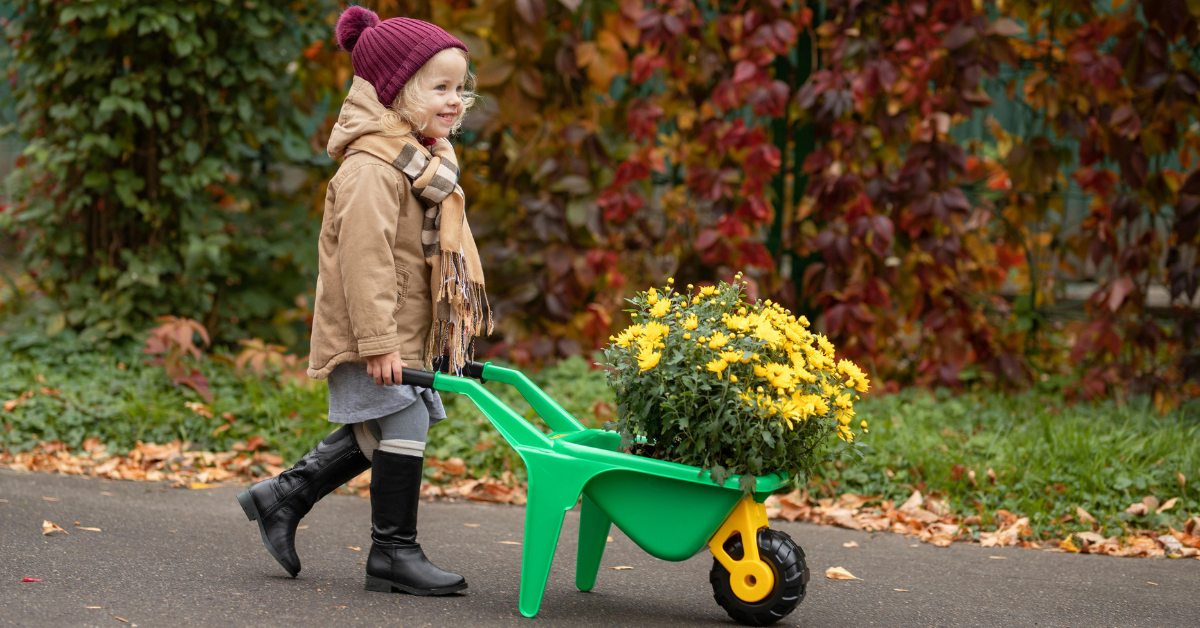
10 Fun Ways to Involve Kids in Gardening and Sustainable Living

*Collaborative Post
Getting kids involved in gardening and sustainable living can be a rewarding experience for both you and them. You can start simple projects like a mini vegetable garden or create garden art that sparks their creativity. These activities not only teach valuable lessons about nature and responsibility but also foster a sense of achievement. Plus, they can learn about the importance of pollinators and composting through hands-on involvement. Curious about how you can turn these ideas into fun, memorable experiences? Let’s explore ten engaging ways to make gardening a family affair.
Start a Mini Vegetable Garden
Starting a mini vegetable garden can be a rewarding adventure for both you and your kids. It’s not just about growing food; it’s an opportunity to bond, learn, and explore nature together.
Begin by choosing a sunny spot in your yard or on a balcony where plants can thrive. Let your kids help pick the vegetables they want to grow. Carrots, radishes, and cherry tomatoes are great options because they’re easy to care for and grow quickly.
Next, gather supplies like soil, seeds, and pots or a small raised bed. Involve your kids in preparing the soil and planting the seeds. They’ll love digging, watering, and watching their plants sprout.
Make sure to teach them about watering schedules and the importance of sunlight, turning each task into a fun learning moment.
As the vegetables grow, encourage your kids to keep a garden journal, tracking their plants’ progress and noting any changes. This will enhance their observation skills and foster a sense of responsibility.
When it’s time to harvest, celebrate your hard work together! Enjoying the fruits of your labor will make the experience even more fulfilling.
Create Garden Art Projects
While tending to your mini vegetable garden, why not ignite your kids’ creativity by incorporating some fun garden art projects?
These activities not only enhance the beauty of your garden but also provide a wonderful bonding experience. Start with DIY plant markers using stones or recycled materials. Let your kids paint these markers with vibrant colors and write the names of your vegetables or herbs. This way, they’ll learn while they create!
You can also create whimsical garden sculptures using found objects like old utensils, bottles, or even broken toys. Encourage your children to use their imagination—perhaps a flower made from a plastic bottle or a bug from a tin can!
Another engaging project is to make bird feeders. Using pinecones, peanut butter, and birdseed, your kids can create feeders that attract local wildlife, teaching them about nature and responsibility.
Organize Nature Scavenger Hunts
Embracing the natural world around you can be a delightful adventure, especially when you organize a nature scavenger hunt for your kids. This engaging activity encourages them to explore their surroundings while learning about the environment.
Start by creating a list of items for them to find, such as specific leaves, rocks, flowers, or insects. You can tailor the list to your local area, ensuring it’s relevant and exciting.
Gather your kids and explain the rules. Give them a bag to collect their treasures and set a time limit to keep the energy high. As they search, encourage them to observe their surroundings closely—what colors do they see? What sounds do they hear? These questions foster curiosity and deepen their connection with nature.
After the hunt, gather together to share findings. Discuss each item and its role in the ecosystem, promoting a sense of stewardship. You can even create a scrapbook of their discoveries, turning it into a fun keepsake.
Organizing a nature scavenger hunt not only builds lasting memories but also plants the seeds for a lifelong love of the outdoors. So, grab your list and get ready for some fun!
Plant Flowers for Pollinators
After your kids have enjoyed their nature scavenger hunt, you can extend their appreciation for the environment by planting flowers that attract pollinators. Pollinators, like bees and butterflies, play a significant role in our ecosystem, and involving your children in this process can be both educational and fun.
Start by selecting native flowers, as they’re often best suited to your local pollinators. Some great options include coneflowers, milkweed, and sunflowers. Let your kids help choose which flowers to plant; this gives them a sense of ownership and responsibility.
When planting, involve them in digging, watering, and caring for the flowers. Talk about the importance of pollinators and how those flowers will provide food and habitat for them.
Encourage your kids to observe the changes in the garden, noting any visiting butterflies or buzzing bees. You can even create a simple journal for them to document their findings!
Involving your kids in planting for pollinators not only beautifies your yard but also fosters a lifelong appreciation for nature and sustainability.
Plus, watching those pollinators thrive will surely bring smiles to their faces!
Make DIY Compost Bins
Have you ever thought about how easy it’s to turn kitchen scraps into nutrient-rich compost? Making DIY compost bins is a fantastic way to engage your kids in sustainable living while reducing waste.
Start by gathering materials; an old plastic bin, wooden pallets, or even a simple wire mesh can work well. Involve your kids in choosing the location—ideally, somewhere sunny to speed up the composting process.
Next, let them help you drill holes in the bin for aeration. This is a great way to teach them about the importance of air in composting!
Once your bin is ready, explain what materials are compostable. Encourage your kids to collect kitchen scraps like fruit peels, vegetable trimmings, and coffee grounds. Show them how to layer greens (nitrogen-rich materials) and browns (carbon-rich materials) in the bin.
Make it a fun routine! Have your kids add scraps daily, turn the pile weekly, and watch the magic happen over time. Not only will you create rich soil for your garden, but you’ll also instill a sense of responsibility and care for the environment in your little ones.
Host a Gardening Playdate
There’s something magical about bringing kids together in the garden, and hosting a gardening playdate can be a delightful way to spark their interest in nature. Invite a few friends over, and create a fun, hands-on experience that encourages teamwork and creativity.
Start by setting up different gardening stations. You could have a potting area where kids can plant flowers or vegetables, a seed station for them to decorate seed packets, and a compost corner to learn about recycling food scraps. Make sure each child has a small plant or seed to take home as a keepsake.
Keep the atmosphere light and playful—play music, share gardening stories, and encourage laughter. You might even incorporate a scavenger hunt to find specific plants, insects, or colors in the garden.
As they dig, plant, and explore together, you’ll foster a sense of community and collaboration. This shared experience can complement other learning opportunities, like attending an online public school, where kids can further explore topics such as sustainability and environmental science. Plus, they’ll learn valuable lessons about nature, responsibility, and where food comes from.
In the end, you’ll create lasting memories while nurturing their love for gardening and sustainable living. So, gather those little hands and watch the magic unfold!
Build Birdhouses Together
Building birdhouses together can be a rewarding project that sparks creativity and a love for wildlife in kids. Not only does it give them hands-on experience, but it also teaches valuable lessons about nature and responsibility.
You’ll be amazed at how much joy you’ll both find in observing the birds that come to call your birdhouse home.
Here are some tips to make the birdhouse-building experience even more enjoyable:
• Choose the Right Materials: Use untreated wood, as it’s safer for birds.
• Get Creative: Let your kids decorate the birdhouse with paint or natural elements.
• Involve Them in Design: Ask for their ideas on shape and size, promoting their creativity.
• Teach About Local Birds: Research what birds frequent your area and make a birdhouse that suits them.
• Hang it Together: Once it’s built, find the perfect spot to hang it and enjoy watching it come to life.
This project won’t only strengthen your bond but also ignite a passion for wildlife conservation that can last a lifetime.
Explore Seed Saving Techniques
Seed saving is an exciting way to connect with nature and empower kids to take part in the gardening process. By teaching them how to save seeds, you’re instilling valuable lessons about sustainability and responsibility.
Start by selecting a few plants that produce seeds easily, like sunflowers or tomatoes. Together, you can observe the different stages of seed development.
Once the seeds are ready, show your kids how to collect them. Make it a fun scavenger hunt in your garden! Let them experience the joy of gently extracting seeds, whether it’s shaking seed heads into a bowl or scooping out seeds from ripe fruits.
Explain the importance of letting seeds dry completely before storing them.
After harvesting, help them label and store the seeds in envelopes or jars. Encourage creativity by decorating the containers! This process not only teaches kids about plant life cycles but also fosters a sense of ownership in their gardening journey.
Learn About Organic Gardening
Organic gardening offers kids a fantastic opportunity to learn about growing food without synthetic chemicals.
You can teach them the importance of nurturing the earth while they get their hands dirty. It’s not just about planting seeds; it’s about understanding how nature works and developing a sense of responsibility.
Here are some fun ways to engage your kids in organic gardening:
• Start a compost bin: Show them how kitchen scraps can turn into rich soil.
• Plant a diverse garden: Introduce them to companion planting and the benefits of biodiversity.
• Use natural pest control: Teach them about beneficial insects and how they help keep pests away.
• Create a garden journal: Encourage them to document their observations, progress, and reflections.
• Practice patience: Gardening teaches them to wait and appreciate the growth process.
Cook With Homegrown Produce
After nurturing those plants and watching them grow, it’s time to bring your harvest to the kitchen. Cooking with homegrown produce not only rewards your hard work but also creates an opportunity for family bonding.
Involve your kids in meal prep by letting them wash, chop, and mix the ingredients. This hands-on experience teaches them about nutrition and encourages healthy eating habits.
Start by picking fresh vegetables or herbs from your garden. Try simple recipes like a veggie stir-fry or a homemade salsa using tomatoes and peppers. Let your children experiment with flavors, adding their chosen herbs to the mix. You might be surprised by their creativity!
Don’t forget to talk about where the food comes from while cooking. Discuss the importance of sustainable eating and how growing your own food can reduce waste.
Encourage your kids to keep a journal of their cooking adventures, noting down recipes and meals they enjoyed.
Conclusion
As you dig your hands into the soil, you’re not just planting seeds; you’re planting a love for nature in your kids’ hearts. Each sprout symbolizes growth, not just in the garden but in their understanding of sustainability. These moments together create lasting memories, like a garden blooming with vibrant colors. Embrace the journey, watch them nurture their plants, and celebrate the beauty of what you’ve cultivated—both in your garden and in their appreciation for the world around them.
*This is a collaborative post. For further information please refer to my disclosure page.




